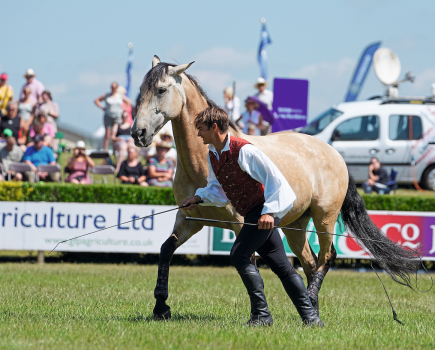There’s a lot more to lunging a horse than going round in circles — incorporating a few lunging exercises makes it a more effective and interesting session for both of you.
Good lunging exercises encourage the horses to use and develop the right muscles, improves suppleness and balance, as well as adding variety to their work schedule.
Trotting and cantering around in endless circles is not the goal here; you want your horse to be working forward correctly, learning to carry themselves, engaging the hindleg, fully focused and listening to you, which will be evident in sharp transitions in response to your voice aids.
This type of work is quite hard, so keep your lunge sessions short — up to 30 minutes is usually plenty — and shorter still if the horse is unfit, young or not used to being lunged.
Warming up
As with any ridden exercise, your horse must be warmed up (and later warmed down) well at the start (and then finish) of every lunge session, advises Grand Prix dressage rider and trainer Sarah Ridd.
Lunging is demanding work, so spend time warming up before asking for more strenuous work. Sarah advises starting with the following exercise:
How to do it:
- Start each lunging session with five minutes of walk and trot without any training aids, like side reins, attached. Remember to do this on both reins.
- How you position yourself will enable you to give your horse clear aids and direct them. Your horse, lunge rein and whip should form a triangle. The horse is the bottom of the triangle while you’re the point at the top of it, and your lunge line and whip form the sides.
- Take this time to watch your horse. You’re looking to see if they stay out on the circle – or perhaps they fall in on one rein. This tells you if they’re struggling with their balance or lack suppleness, and what you need to work on.
- During this warm up phase, make sure that you work your horse equally on both reins, noting whether they move differently on one rein to the other.
Forward transitions
Hayley Watson-Greaves, British Dressage supreme national champion in 2017, explains an exercise that teaches a horse to move forwards, helping towards medium trot and medium canter work. It also helps improve balance.
How to do it:
- Transition from trot to walk three times.
- In trot, ask the horse to transition to a more forward trot by stepping forward with your leg towards the horse’s shoulder and using your voice in a jolly, upbeat, short-sharp tone. Flick your whip to back up your voice aids if needs be.
- Aim for five good transitions from trot to forward trot before asking for canter.
- Repeat on the other rein.
- Vary moving up and down between the paces as well as asking for more forwardness within a pace, to give your horse a really good work out and keep them listening and focused on you.
- Your horse will need to push off the ground with their hind leg as you ask for more forwardness. With enough practise, this will help to strengthen their hind legs.
Cantering
According to classical dressage trainer Diane Followell, working your horse in canter on the lunge can really help to develop this pace by improving their balance and engagement.
If, for example, your horse tends to rush in canter, improving their balance will make it easier for them to slow down and maintain canter for longer.
If they’re a little slow with the inside hind, a balanced canter transition will help engage it.
How to do it:
- Establish a well-balanced trot on a large circle.
- The place to ask for a canter will depend on your horse. If they tend to hug the wall, then ask on a closed side of the circle.
- The first few times you ask for canter, you may find that they run on in trot rather than transitioning. Slow the trot down and then repeat your instruction, possibly with a flick of your lunging whip towards the hock. Repeat this until your horse canters.
- If the horse loses balance and becomes disunited, or if they change lead to the outside leg, come back to trot.
- Reestablish the trot rhythm and balance and then ask for canter again.
- The canter may be unbalanced initially and your horse may rush on. If this happens, very gently give and take on the lunge line to help them rebalance and use your voice to maintain the canter rhythm.
- When the horse returns to trot, they may run on to the forehand. Gently steady them with the lunge line and your voice until they regain balance and natural trot rhythm.
- Don’t expect your horse to canter for a long time. One circle is enough to start with.
- Avoid asking for a transition up or down in the same place too. Vary where the horse is on the circle so that they don’t begin to anticipate the change in pace.
- Give the horse plenty of breaks. Lunging is demanding both mentally and physically for the horse.
Stretching
“What people forget is that the scales of training apply even on the ground. Your horse is still in work, regardless of whether you’re sitting on their back or not, so rhythm, contact, suppleness and so on, need to be achieved,” states classical dressage trainer and author Claire Lilley.
“Your horse needs to be encouraged to lower their head while working on the lunge. This will engage and strengthen the abdominal muscles, and help them work in an outline as they develop a stronger core.
“Strong, supple horses should be able to stretch in walk, trot and canter with their noses practically on the ground, so use of poles or anything that encourages them to look down may help.”
How to do it:
- Encourage your horse to stretch down using poles on the ground. Lunging over ground poles is a great way to strengthen your horse’s back and build muscle.
- Move around the arena and change direction regularly. Moving around allows for some straight line work for variety too.
- Allow freedom of movement and natural rhythm. Moving too fast causes tension in a horse; too slow will not develop their movement.
- Start by making frequent transitions between walk and trot, and trot and canter, and bear in mind that using plain side reins — in other words, non-elasticated ones — can help your horse to maintain their balance, especially in canter.
- Incorporate stretching forwards and downwards over poles without side reins into your lunging sessions. Do this in walk and trot before progressing to canter.
Leg yield on a circle
Be creative and push the boundaries a bit when you’re lunging, says Sarah Ridd who runs Weymarsh Equestrian, as it will help to keep your horse fresh and interested in the work you’re asking them to do.
How to do it:
- Start on a large circle and encourage your horse to move forwards in a positive, forward-thinking walk.
- Mix it up a little and gradually reduce the size of the circle, then push the horse back out again onto a larger one.
- I like to walk around with my horse while lunging, rather than standing still in the same spot. This allows you to add in some straight lines for a few strides before returning to a circle.
- Maintain your position and make sure your horse is staying in a good walk rhythm.
- Now up the pace to trot and repeat the above steps. Remember that the focus is to make sure your horse is working from behind into the contact.
- Add in some changes of pace, such as transitions between paces or within the pace, to keep your horse listening.
Poles on a circle
How to do it:
- Set four poles at the quarter marks of a circle so that your horse can work around the outside of the poles on a 20m circle, or over them on a 15m circle.
- Position yourself in the middle of the poles, and start off with your horse in walk before progressing to trot or canter.
- After three or four circles on each rein, take your horse around the school on straight lines by walking (or running) beside them. This will improve horse’s balance and prevent them from ‘motorbiking’ — ie, falling in and taking too much weight on the inside hind and not enough on the outside hind.
- Look for your horse to be taking weight evenly on all four legs. This is why it’s important to work a horse on straight lines as well as circles.
Leg yield over poles
This exercise will help improve your horse’s balance and stride length.
How to do it:
- Set out four or five ground poles in a fan shape on a 20m circle. Leave six to eight steps between each pole, depending on your horse’s stride length.
- Walk your horse in a circle across the end of the poles nearest you.
- Ask the horse to spiral out from that circle until they reach the middle of the poles. If you want a slightly bigger stride, aim for the outside of each of the poles.
- Repeat on the other rein.
- Your horse should be stretching their neck down as they step over each pole.
To vary the exercise:
Set four poles at the quarter marks of a circle so that your horse can work around the outside of the poles on a 20m circle, or over them on a 15m circle.
Ask them to spiral in and out to vary the size of circle the horse is working on, which will require them to step over different parts of the poles.
Turn on the forehand
Remember, continues Sarah Ridd, that lunging is hard work for your horse so working them equally on both reins is important.
I like to use a turn on the forehand from halt to change the rein with my own horses. The crossing action of the horse’s hindlegs during this movement will help to improve their suppleness.
How to do it:
- Ask your horse to halt. Walk towards them and position yourself by their head.
- Ask them to bend their head and neck a little to the inside while you gently tap the whip against their inside hindleg to ask them to step away from you.
- Allow the horse to move their hindquarters away from you. You may need to repeat the aid so that they keep moving until they’re facing in the opposite direction.
- Now step backwards away from their head and ask them to walk forwards on the new rein. Now repeat exercise 2 on this rein.
Going large
Once you’ve established that you’re in control on a circle, vary it a little and make full use of your arena, advises Sarah Ridd.
How to do it:
- Ask for a 15m circle in the corner of the school and then continue down the long side.
- Once straight, ask for some medium trot steps and then go back to working trot.
- Go onto another 15m circle in the next corner – this is great for your fitness too, as you’ll need to jog with your horse.
- If your horse is young, inexperienced, or needs time to learn this new exercise, begin in walk and progress to trot when you’re both ready.










